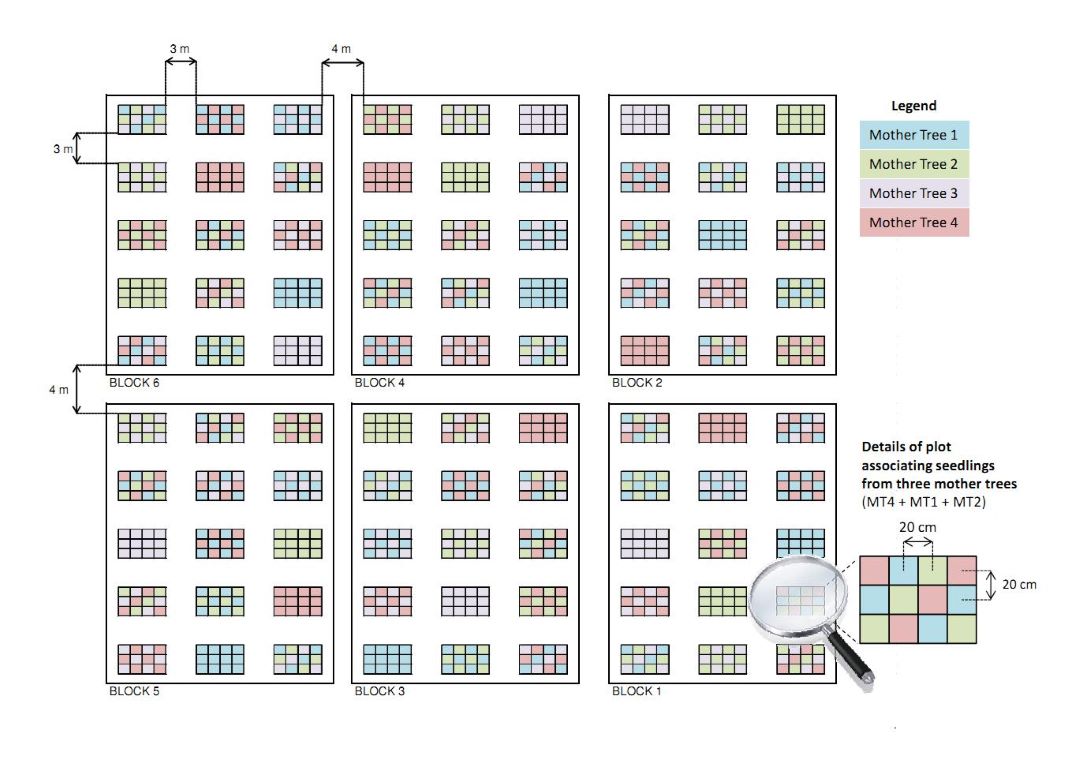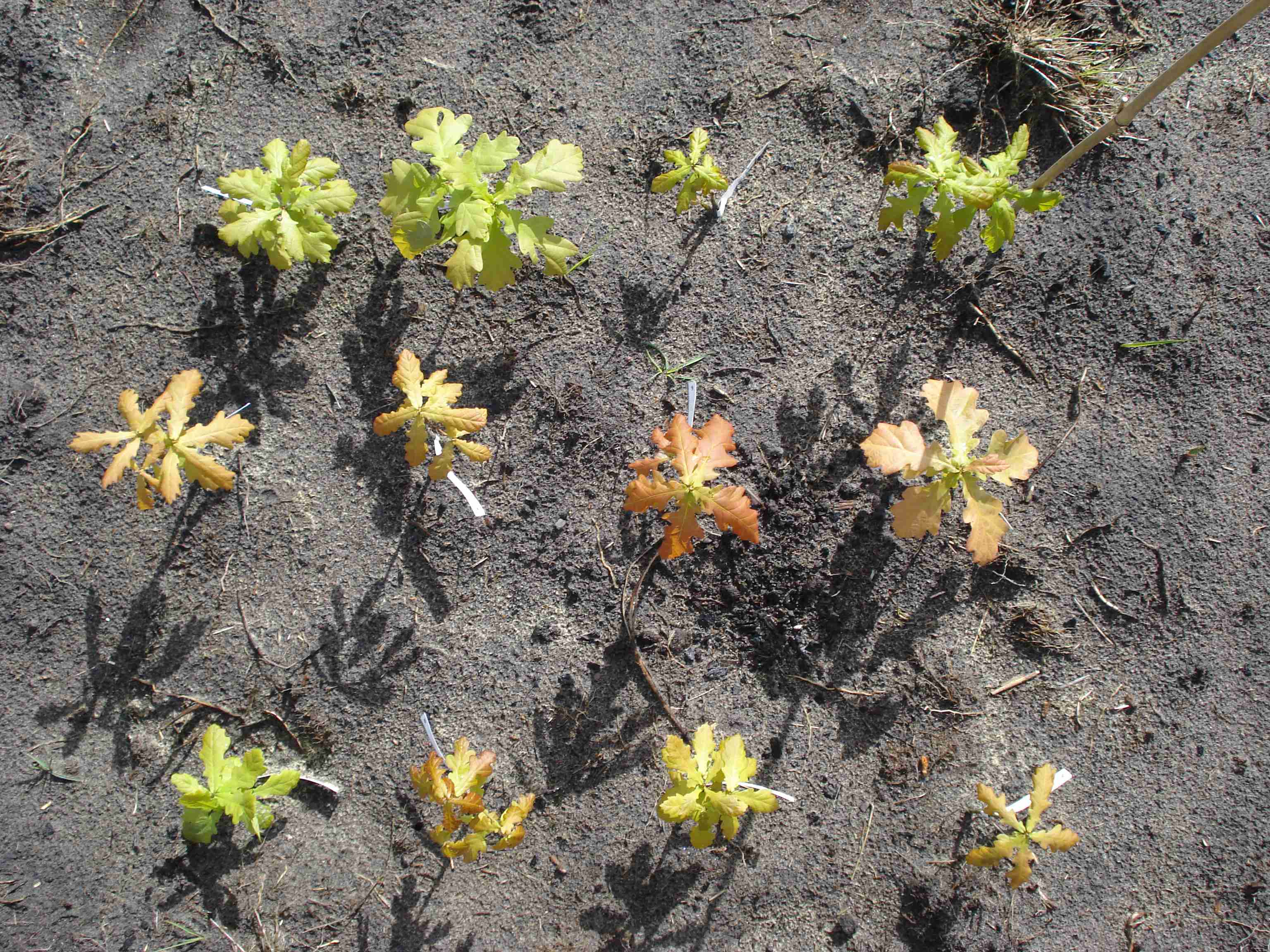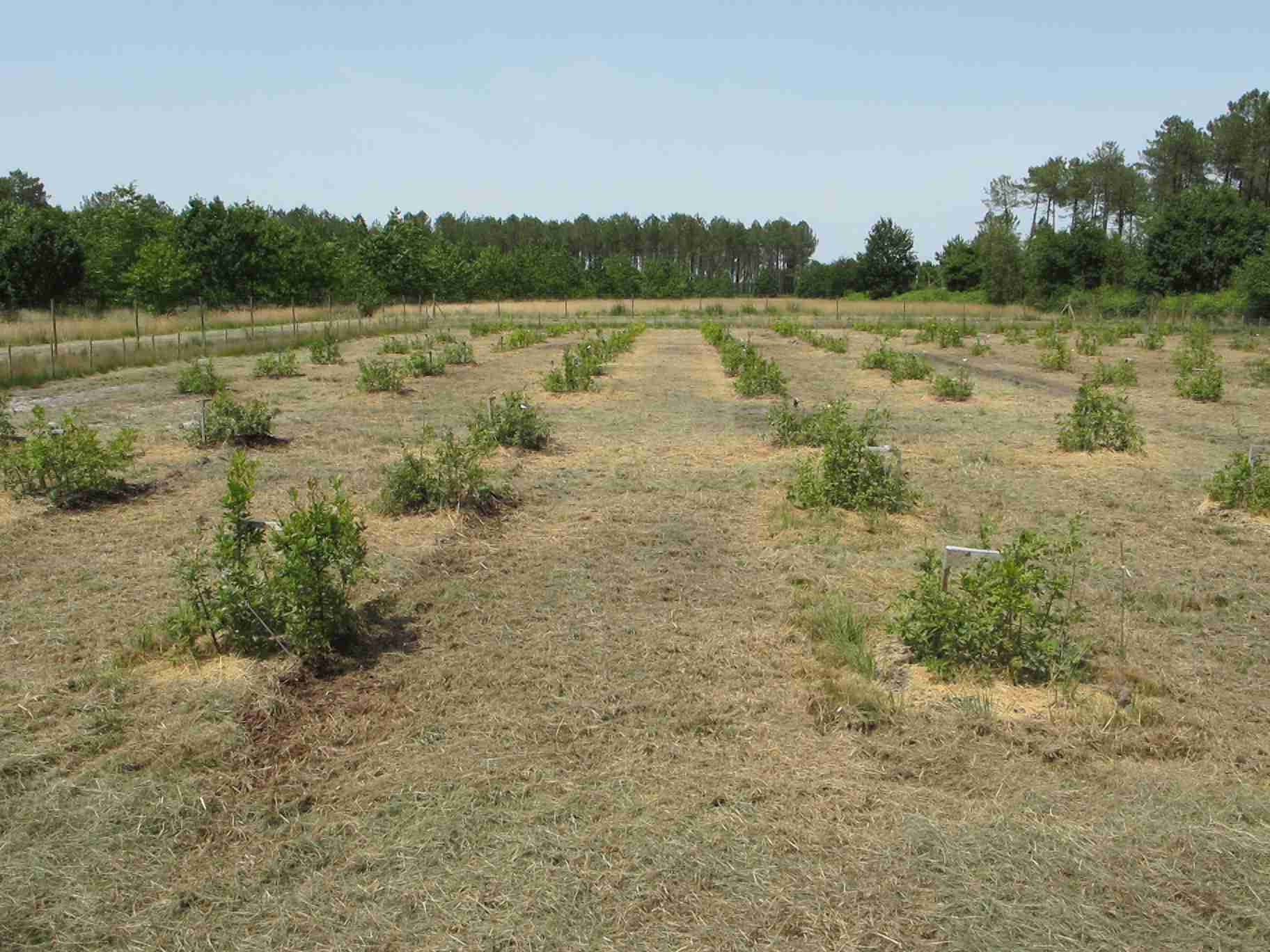Communitree (France)
Communitree, established in 2009, is a small common garden experiment with 90 synthetic mixtures of oak saplings composed of one to four half-sib families. The goal of the experiment is to investigate the effects of genetic diversity in plant populations on ecosystem functioning (productivity, stability, resistance to herbivores). The experiment is located in southwestern France, close to the ORPHEE experiment.
Design
Acorns were selected from the canopy of four mature pedunculate oaks (Quercus robur) growing within 10 km of the planting site in autumn 2007. The acorns were sown in the INRA nursery in March 2008; seedlings were grown in individual pots. The seedlings were transplanted in the field in March 2009. Six blocks were established, with 15 plots per block. The plots were separated by a distance of 3 m and were randomly distributed within the blocks. Blocks were 14 m x 6 m in size and were located 4 m apart. Plots were planted with seedlings of 1 to 4 mother trees. In each block, all possible mother tree combinations were represented: one mother tree (n = 4 plots), 2 mother trees (n = 6), 3 mother trees (n = 4) and 4 mother trees (n = 1) per plot. Each plot contains 4 rows of 3 seedlings; the seedlings were planted 0.2 m apart; and the plot area was 0.24 m2 (0.6 m x 0.4 m). Within each plot, the seedlings from the different mother trees were planted at equal density in a regular alternate pattern, such that seedlings from the same mother tree were never adjacent in mixed plots.

Site characteristics
| Communitree (Pierroton) | |
|---|---|
| Country | France |
| Biome | temperate |
| Latitude | 44.67 |
| Longitude | -0.77 |
| Soil type | sandy podzol |
| Former land use | pine plantation |
| Altitude | 57 m |
| Design | regular alternate pattern |
| Plot shape | rectangular |
| Plot size (m^2) | 0.24 m² (pots) |
| Plant distance (m) | 0.2 |
| Number of trees planted | 1080 |
| Planting date | March 2009 |
| Diversity variables | genetic diversity genetic relatedness |
| Diversity gradient | 1, 2, 3, 4 half-sib families |
| Size species pool | 1 (4 mother trees) |
| Species pool | Quercus robur |
| Contact person | Hervé Jactel |
| herve.jactel@pierroton.inra.fr |
Research
All saplings were genotyped and the level of genetic diversity was assessed in each mixture. Monitoring includes damage caused by generalist and specialist insect herbivores and above- and belowground biomass production in order to study relations between genetic diversity, primary production, food availability, herbivory damage, and host specialization of herbivores.
Extra information
Send an e-mail to the contact persons or explore the publications that utilized data from this experiment.
Research papers
- Depauw L, De Lombaerde E, Dhiedt E, Blondeel H, Abdala-Roberts L, Auge H, Barsoum N, Bauhus J, Chu C, Damtew A, Eisenhauer N, V. Fagundes M, Ganade G, Gendreau-Berthiaume B, Godbold D, Gravel D, Guillemot J, Hajek P, Hector A, Hérault B, Jactel H, Koricheva J, Kreft H, Liu X, Mereu S, Messier C, Muys B, Nock CA, Paquette A, Parker JD, Parker WC, Paterno, GB, Perring MP, Ponette Q, Potvin C, Reich PB, Rewald B, Scherer-Lorenzen M, Schnabel F, Sousa-Silva R, Weih M, Clara Zemp D, Verheyen K, Baeten L 2024 Enhancing Tree Performance Through Species Mixing: Review of a Quarter-Century of TreeDivNet Experiments Reveals Research Gaps and Practical Insights. Current Forestry Reports - https://doi.org/10.1007/s40725-023-00208-y
- FAO 2023 Towards more resilient and diverse planted forests. Unasylva (254)74: 2031/1. Rome. https://doi. org/10.4060/cc8584en
- Messier C, Bauhus J, Sousa-Silva R, Auge H, Baeten L, Barsoum N, Bruelheide H, Caldwell B, Cavender-Bares J, Dhiedt E, Eisenhauer N, Ganade G, Gravel D, Guillemot J, Hall JS, Hector A, Hérault B, Jactel H, Koricheva J, Kreft H, Mereu S, Muys B, Nock CA, Paquette A, Parker JD, Perring MP, Ponette Q, Potvin C, Reich PB, Scherer-Lorenzen M, Schnabel F, Verheyen K, Weih M, Wollni M, Zemp DC 2021 For the sake of resilience and multifunctionality, let’s diversify planted forests! Conservation Letters e12829 - https://doi.org/10.1111/conl.12829
- Grossman JJ, Vanhellemont M, Barsoum N, Bauhus J, Bruelheide H, Castagneyrol B, Cavender-Bares J, Eisenhauer N, Ferlian O, Gravel D, Hector A, Jactel H, Kreft H, Mereu S, Messier C, Muys B, Nock C, Paquette A, Parker J, Perring MP, Ponette Q, Reich PB, Schuldt A, Staab M, Weih M, Zemp DC, Scherer-Lorenzen M, Verheyen K 2018 Synthesis and future research directions linking tree diversity to growth, survival, and damage in a global network of tree diversity experiments. Environmental and Experimental Botany 152: 68-89 - doi: 10.1016/j.envexpbot.2017.12.015
- Koricheva J, Hayes D 2018 The relative importance of plant intraspecific diversity in structuring arthropod communities: A meta-analysis. Functional Ecology 32: 1704-1717 - doi: 10.1111/1365-2435.13062
- Fernandez-Conradi P, Jactel H, Hampe A, Leiva MJ, Castagneyrol B 2017 The effect of tree genetic diversity on insect herbivory varies with insect abundance. Ecosphere 8: e01637 - doi:10.1002/ecs2.1637
- Castagneyrol B, Lagache L, Giffard B, Kremer A, Jactel H 2012 Genetic diversity increases insect herbivory on oak saplings. PLoS ONE 7: e44247 - doi: 10.1371/journal.pone.0044247

